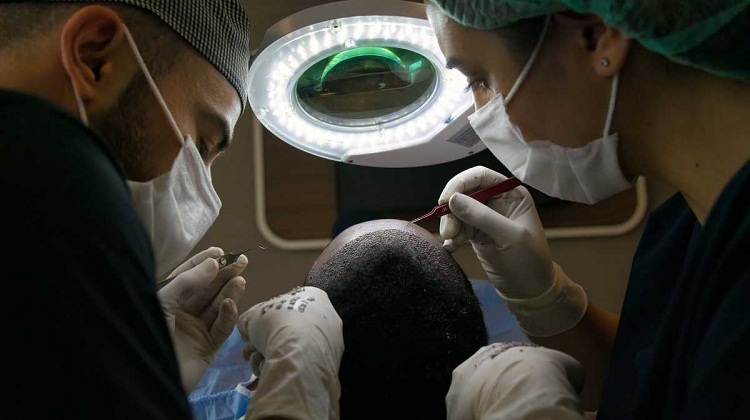
Post Preview
In a hair transplant, protected, permanent hair follicles from the sides and back of your head are surgically transplanted to bald or thinning regions. It takes two distinct processes to get the job done: donor harvesting and recipient site preparation. Your healthcare provider will use a scalpel or needle to create holes or slits in the scalp. They can use round punch grafts, which contain about 10-15 hairs; mini-grafts, which are dissected from strip grafts; or micro-grafts, which are one to two hairs.
How Does It Work?
In a hair transplant, doctors remove healthy hair follicles from another part of your scalp and move them to where you lose hair. The surgeon may use two different methods to do this. The first procedure, follicular unit transplantation (FUT), entails chopping up a strip of skin from the back of your head into 500–2,000 tiny grafts. The grafts are then placed where they will grow hair, usually on the top or back of your head (the classic horseshoe shape). Depending on how much hair you need to restore, you may need multiple procedures.
Unlike some other hair restoration products, hair transplants work. However, they will still be successful for some. The success rate depends on your condition, age and other factors. Getting a consultation with a qualified plastic surgeon before surgery is important. So that you may make an educated choice, they will assist you in understanding the procedure’s dangers and advantages. They will also give you tips for preparing for surgery and recovery.
What Are the Results?
Your surgeon will remove the bandages and may spray your scalp with an anti-swelling drug (triamcinolone). The transplanted hair follicles might be slightly scabby and tender, but this usually heals within a few days. In a FUT procedure, your surgeon will use a scalpel to remove a strip from the back of your head (the donor area). They will then separate this into tiny sections called follicular units that contain one or more hair follicles each. These will then be transplanted to areas of your scalp that are bald or thinning.
Generally, your surgeon will place these follicles in a random pattern to mimic natural hair growth. You might need several surgical sessions to achieve satisfactory results, and you will likely need to wait six to nine months for new hair to grow. The type of hair you have also impacts the results. Coarse, light-colored or gray hair typically provides better coverage than fine, dark strands. After a successful hair transplant surgery, your hair will thicken and grow over time.
What Are the Recipient Sites?
Follicular units (natural clusters of 1 to 4 hairs) are moved from the sides and rear of the scalp to bald or thinning regions on top during hair transplantation. Modern techniques utilize a strip excision on the back of the head and a stereomicroscope to dissect this into individual follicular units for transplantation. Once local and tumescent anesthesia is applied along your specified frontal hairline, the recipient sites are created using needles or punches with a diameter of 0.08 to 1.2 mm. These holes dictate the angle, direction and distribution of each inserted graft. The quality of the recipient site creation determines to a large degree, the success and aesthetic outcome of your procedure. Before your surgery, you’ll be asked to avoid any medications affecting hair growth, such as blood thinners. Your surgeon may also ask you to stop smoking or limit alcohol intake. It is to reduce the risk of complications. There’s a chance some of the follicles may not “take” (grow new hair). In these cases, your doctor may perform a “touch-up” procedure to fill in these spots.
What Are the Donor Sites?
A hair transplant uses grafts of your hair from areas with dense and thick hair (the back and sides of the scalp) to restore your thinning or balding areas. Your surgeon will choose the best places to use based on your needs. Your donor site will have small “dot-like” scars that will be concealed by your hair when it grows. When your hair reaches a length of 1 or 2, these will be unnoticeable.
For follicular unit strip surgery (FUSS), your surgeon will remove a strip of hair-bearing skin from the back of your head using one or more single-, double-, or triple-bladed scalpels. The strip is then dissected under magnification into individual follicular units (one to three follicles each) or groupings of four to six follicles. Your surgeon may also use hair from your beard or chest (though these are usually thinner and less resistant to DHT). If you need more natural hair, they can add follicles from the legs and arms, although this technique is more time-consuming.
How Long Will It Take?
Before the surgery, your doctor will clean your scalp and inject anesthesia. Then they will use one of two methods: follicular unit transplantation (FUT) or follicular unit extraction (FUE). In follicular unit transplantation, surgeons remove a strip of your scalp using a scalpel that may be 6-10 inches long and stretch from ear to ear. They then cut that scalp strip into 500 to 2,000 smaller pieces, called grafts. These grafts are then placed into your head by your surgeon and possibly other team members. The surgeon takes 4-8 hours to put all the grafts. Once the grafts are in place, they will take a few months to grow and thrive, just like your natural hair. It will make them blend in better with your natural hair.
In some cases, they may even make your hair fuller. But the success of your transplant will heavily depend on the overall health of your follicles and your age. You will also want to communicate openly with your surgeon about your goals and expectations so they can help you avoid unrealistic results.






